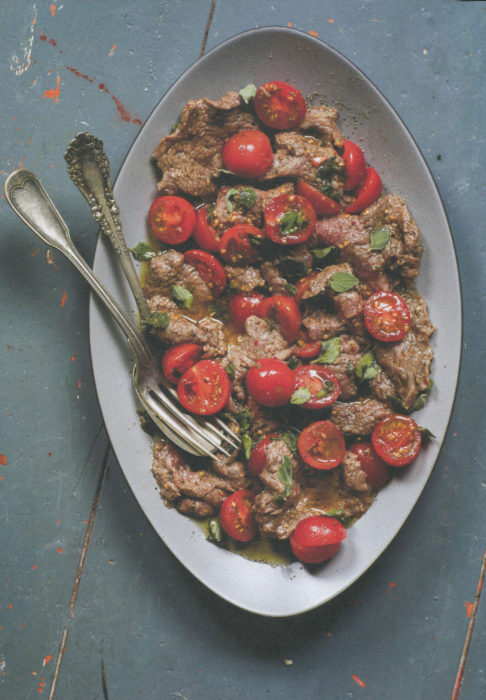
Tel Aviv is an historic city nicknamed The White City because of its thousands of Bauhaus buildings. With under a half million people it is not huge, but it is getting there.
We often think of cities as mixtures of concrete, brick, steel and glass. Firm and permanent things. But cities are much more than that and the Tel Aviv city landscape is wildly organic. Jigal Krant writes about the history and changing patterns of Tel Aviv life is this important cultural as well as culinary book. Twenty-five years ago, Tel Aviv was a bit ragged. Then, changes began.
The pace of change is actually accelerating. The skyline, once low, is dotted with tall apartment buildings and there is a network of construction cranes building more and more. Rents are skyrocketing to levels worse than New York. Long-time residents have to leave. New ones arrive.
And those new ones? Some come from outside the country, often with the wealth to retire in a beach city with superior climate. Many come from other parts of Israel, particularly Jerusalem. The rise of very strong Orthodox communities in Jerusalem can make life difficult there. Go for a bike ride on the Sabbath, and you may find stones crossing your path.
In Tel Aviv, they don’t care. They don’t close businesses on the Sabbath. They don’t stress about food being kosher. They are all about food being great and authentic to their land.
Food in Tel Aviv is being described as world-class. For Jigal, a food writer and authority who has lived in Europe and New York, the food is definitely wonderful and most distinctive. Tel Aviv cuisine is all about two things: seasonings — tahini, za’atar, sumac and silan [date syrup] — and a predilection for vegetables and flames. Charring eggplant and peppers are central to many of the dishes.
The book has 100 recipes, a third of them Jigal’s interpretations of classics. Some recipes are chef ideas, but Jigal notes they are best experienced in Tel Aviv with local ingredients. And Jigal reminds us that many restaurants do not use cutlery – its comfort food in your fingertips.
Tel Aviv has three main chapters: Eat With Your Hands, At TheTable, and Salatim [Salads].
Life in the city is often darting. The chapter Eat with Your Hands focuses on the quick dishes of tiny shops and street carts. There is Sabich [yes like sandwich]: pitta with eggplant, egg, and multiple sauces. [Jigal writes “pitta” and not “pita” so I will too.]. There is Arayes, toasted pitta filled with spicy minced lamb. Pitta with Lamb Meatballs: pine nuts, onion, cloves, harissa, parsley, tomatoes, onion and coriander. It can get cold in Israel, it can snow, so then you drink thick Sachlab: milk, whipping cream, rosewater, cornstarch, cinnamon and pistachios. Eggplant is always on hand, like Eggplant Schnitzels served with a sauce of yogurt, tahini, mint, and lemon juice.
Pitta is a staple. You can have simple Pitta Bruschetta: olive oil and garlic. Or add tomato and za’atar or oregano. Or with mozzarella, mint pesto and pomegranate seeds. Or with caramelized onions, mushrooms anchovy, thyme and splash of Campari. Pitta is a platform that supports a myriad of dishes from the simple to the surprising.
In At The Table we encounter dishes with more heft. These are restaurant home kitchen ideas where a knife and fork are often required:
Roasted Eggplant with Tahini, Hazelnuts and Pomegranate Seeds
Roasted Radish and Spring Onion with Mackerel and Sumac Plus Yogurt
Beet Carpaccio
Smoked Beef Tongue with Beets and Quail Eggs
Roasted Eggplant and Apple with Date Syrup
Beef Tenderloin with Fire-Blackened Eggplants and Bell Peppers
Salmon Ceviche with Avocado, Grapefruit and Arak
White Chocolate Cake with Almonds and Limoncello
Finally, in Salatim we discover how wide the interpretation of “salad” can be:
Roasted Bell Peppers with Goat’s Cheese and Pine Nuts
Watermelon Salad with Apple, Grapefruit and feta
Flash-Fried Beef and Plum and Herbs
Labneh with Pistachio, Pomegranate, Soy and Silan
Black Quinoa with Roast Bell Peppers, Radishes and Black Olive
Tel Aviv is a maze of cultures and history. Jigal delves down those byways in both text and exceptional photographs of the city and the city’s people. He describes the intermix and appreciation for both Sephardic and Ashkenazi cuisines.
The book is, in a word, beautiful. It does inspire you to visit Israel to experience dishes you have not imagined before. And, if you cannot fly there next week, this book is now ready for you to buy, use, and savor. One pitta at a time.
The recipes are quick, the ingredient lists short, the flavors immense.
Here’s a sample food picture, the Kosher Beef Tagliata. I’ll post the recipe later today or tomorrow. No, the beef is not cooked, just cut thin and then marinated in spices, olive oil, vinegar and chili flakes for a couple of hours.

